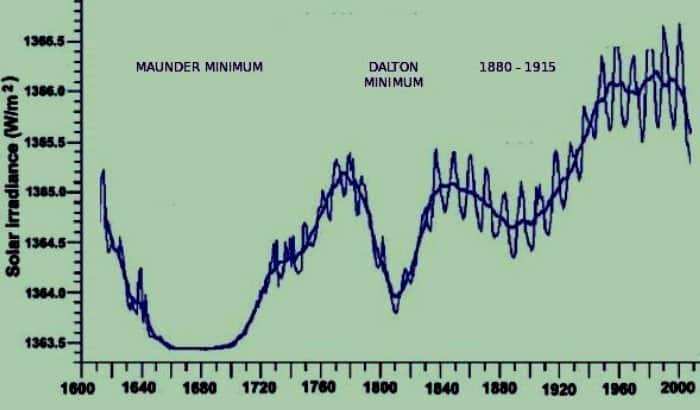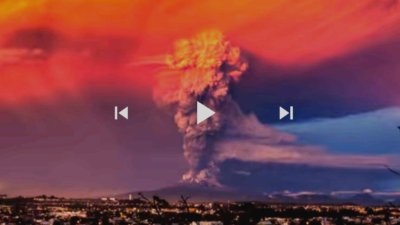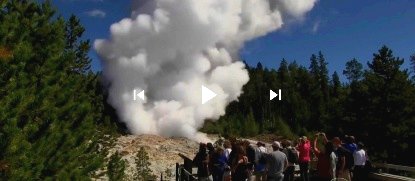Are Volcanic Eruptions Increasing?
Is volcanic activity increasing around the world? Many articles are blaming climate change and global warming for the volcanic activity. The irony here is, we are going into a long cooling period, called a grand solar minimum. This is already making the scientists and professors that have supported the global warming agenda look foolish.
This is why they are changing the narrative from global warming to climate change. As the next 30 years or more pass, they will be exposed, it’s already happening. In this article we are going to show you some of the most notable and powerful volcanoes ever, and how so many of them correlate with the timing of the grand solar minimums.
Video of Recent Volcanic Eruptions.
Here are some some of the more recent volcanoes, that have been caught erupting on film. They really put together an awesome compilations of the eruptions that we might be able remember, from Mt. Saint Helens forward.
There is even footage from hikers that were lucky enough to survive recording an eruption. They were climbing one of Japan’s volcanoes at the moment it erupted.
Volcanic Eruptions during Grand Solar Minimums.
I’ve noticed in most articles, they will not show you the correlation between the dates of the eruptions, and the grand solar minimums, this is because it goes against they’re global warming agenda. They’ve been trying to make us pay Carbon Taxes folks. Or Carbon Offsets as they like to call them now.
We’ve all had the term Carbon Footprint drilled into our heads, the part that is less known is, how many times they have attempted to pass these carbon taxes. It’s always in the name of saving the world, from what they used to call global warming, but are now calling climate change. Yes there is climate change, but it’s because of the sun and it’s cycles.
I just felt this needed to be mentioned, because while double-checking the dates of volcanic eruptions and solar minimums for this article, I ran into a barrage of propaganda that’s meant to make you believe that you’re responsible. It’s your carbon footprint you know…
What is a Grand Solar Minimum?
So now let’s talk about some of the most famous volcanic eruptions and their timing with the solar minimums.
For those of you who haven’t heard of a solar minimum, a solar minimum happens about every 11 years when the sun’s poles flip, so it goes from a maximum to a minimum every 11 years.
Now there’s a larger cycle that they call a grand solar minimum, when the sun really goes inactive for a long period of time. This has been responsible for things such the Little Ice Age, and has even caused famines that have brought down Empires.
The larger grand solar minimums happen approximately every 400 years, with a smaller one sometimes in between them, approximately 200 years. It appears that we’re heading into the larger 400 year grand solar minimum, many are calling this one the Eddy Minimum.
40 to 70 years of increasing volcanic activity?
We’ve just begun entering this cycle, and a grand solar minimum generally lasts about 40 to 70 years. During a grand solar minimum, volcanic activity and extreme weather increases. This is because our Earth’s magnetic shields dramatically decrease.
When solar activity decreases, there is an increase in coronal holes on our sun, this increases the solar wind and the electromagnetic interaction with our planet. There’s a correlation with this and increased earthquakes which can trigger volcanoes.
The Laki Volcano
Let’s talk about the Laki volcano, it erupted in 1783-1784 as a huge volcanic fissure in Southern Iceland. It is considered to be the greatest lava eruption in all modern recorded history. Notice that this is right before we entered into the Dalton Minimum 1790-1830. The cycle of the sun’s activity, was already seriously decreasing at this time. See the chart below for a graph of the grand solar minimum time tables.
Mt. Tambora in Indonesia.
Another one was Mt.Tambora in Indonesia, it erupted in 1815, notice how this is not only entering, but it is during the Dalton Minimum. The researchers said that Mount Tambora the largest volcanic eruptions in 10,000 years. The year after this, 1816 is known as the year without a summer, it even snowed in New York in June. This all happened during a grand solar minimum.
The Salamas Volcano – Mt. Rinjani.
Now let’s talk about the Salamas Volcano, it could be the largest volcanic eruption in human history. Scientific tests point to the eruption occurring at the caldera, that’s next to what remains of Mt. Rinjani, on the island of Lombok.
It acquired the name the Samalas Volcano back when they only knew the time of the eruption, and not the location. At first, they only knew that it had erupted somewhere near the equator, then they began finding scientific evidence, that suggests that it erupted at the caldera beside Mt. Rinjani.
It took an incredible amount of science and research to come up with this location, it was much easier to establish the time of the eruption, which was 1257-1258. The Wolf Minimum was 1280-1340. So this eruption was also on the decreasing solar cycle, heading into a grand solar minimum.
What do the volcanoes have in common?
So what do the volcanoes above, all have in common? They all happened either just before, or during a grand solar minimum. Wondering if this was a coincidence, I decided to do more digging. What I ended up finding was, that most of the famous eruptions have that same sort of timing. This is what inspired me to write this article.
Mount Unzen in Kyusha, Japan.
Mount Unzen erupted in 1792. This was the most deadly volcanic eruption in Japan’s history. It was the huge landslide and tsunami that was caused by the volcano, that claimed the lives of an estimated 15,000 people. Note that the eruption of Mount Unzen also occured during a grand solar minimum. The Dalton Minimum 1790-1830.
Volcanic activity heading into a solar minimum.
During my research for this article, I noticed there were a lot of monster eruptions that were happening as we were heading into the minimum. These were happening up to 50 years before, well at this point, it’s already well on it’s way into the cycle, and the solar activity is already substantially decreasing.
One of these volcanoes is the Huaynaputina Volcano in Peru which erupted back in 1600.
The Huaynaputina Volcano in Peru.
This was the largest historical eruption for South America, and one of the worlds largest volcanic eruptions in 2000 years. Hot mud flows made it all the way to the Pacific Ocean 120km. away. There are reports of this effecting the weather as far away as China and Korea, making it very cold and causing widespread disease outbreaks.
The Huaynaputina Volcano erupted in 1600, as we were heading into one of the most significant grand solar minimums of our time, this minimum was so strong that the Little Ice Age happened during this period. This was the Maunder Minimum. 1645-1715.
Kilauea Volcano in Hawaii.
The Island of Hawaii is created by five volcanoes, out of the five, Kilauea is the most active. So it’s not uncommon to see Kilauea erupt, but it’s big eruption happened in 1790. Both the Laki Volcano and Kilauea were VEI-4 in strength, and both erupted as we were entering the Dalton Minimum 1790-1830.
Novarupta Volcano in Alaska.
Novarupta erupted on the Alaskan peninsula, in the Katmia National Park in 2012. It was the most powerful eruption of the 20th century. This was rated as a VEI-6 eruption, and ejected 30 times as much ash into the atmosphere than the Mount Saint Helens eruption.
There were a lot of volcanoes that erupted in this period of time, in the late 1800’s and the early 1900’s. This was not during a named grand solar minimum, however, if you look at the charts, there is a substantial dip in the solar activity during this period.

Krakatoa on Rakata Island in Indonesia.
This is one to keep an eye on, it is very active and just erupted in 2018. This eruption caused a massive mudslide and a tsunami. This really made for some beautiful pictures, but it was a small eruption compared to when it erupted back in 1883.
The 1883 eruption of Krakatoa was so powerful, it may have been the loadest noise ever on Earth. It was heard 2000 miles away in Western Austraila and New Guinea, it was even heard 3000 miles away in the island of Rodrigues in the Indian Ocean.
This volcano is so active today, and has such potential for a big eruption, that I felt It should be mentioned.
Recent volcanic activity. Our current Eddy Minimum.
From this point forward, we will only be covering more recent volcanic activity, now that we’re entering into the new Eddy Minimum. So we will be adding to this article as more noteworthy volcanic eruptions happen.
Mt. Pinatubo – Luzon Island, Philappines.
This was the largest eruption of most of our memories, It was the second largest volcanic eruption of the 20th. century. Only to be out dune by Alaska’s Novarupta volcano back in 1912.
Mt. Pinatubo was dormant for 400 years before it blew, with it’s monster VEI-6 eruption in June of 1991. There was a column of ash rising 30km. or 19 miles into the stratosphere.
At least there was some warning before it erupted, a smaller eruption happened prior to the big one, there were earthquakes, and they had instruments measuring the sulfur dioxide in the air. This saved a lot of lives because there was some time, for those who wanted to, or were able to evacuate. This was a very sad story because it happened in an area where not everybody had the means to evacuate.
An estimated 300-700 lives were lost, most weren’t because of the blast from the eruption, but were because a tropical storm came in afterwards, and the weight from all of the wet ash on the rooftops caused the homes to collapse. It also caused all the ash to turn into a wet concrete like substance, and flowed down the hills destroying almost everything in it’s path. They call these flows Lahars.
Mt. Pinatubos eruption was so devastating that they had to evacuate the American Clark Air Force Base which was some 15 kilometers away. Many soldiers held out, but then ending up fleeing through a raining mud like ash. There was so much damage done to the base, that Clark Air Force Base was closed down , and never reopened.
Steamboat Geyser – Yellowstone.
There is one thing that a lot of people are paying attention to right now, it’s called the Steamboat Geyser and it’s located in Yellowstone National Park. This is the world’s largest and most powerful geyser. In the past, it would only erupt on rare occasions, it only erupted 10 times in 27 years.
Now over the last couple years it has become much more active, as a matter of fact, in 2018 it’s set a record for an unheard-of 32 eruptions in one year. Now this year in 2019, by June there was already 25 eruptions, and this was only halfway through the year.
In June of 2019 the Steamboat Geysers also set another record, this one was for the shortest time between eruptions, it only took 3 days from one eruption to the next. So at this rate, 2019 will far surpass the record set in 2018. The geyser used to only erupt once every 2 or 3 years, now it erupts every few days. This is over a hundred times more frequently than it did just a few years ago.
There have also been roads in Yellowstone that were getting so hot that they melted, andGPS data is showing that the ground of the Yellowstone caldera has been rising over the last few years. The USGS has confirmed this, and even put out a full color map showing how the caldera is bulging. So there is no doubt, there are dramatic increases in the volcanic activity that are going on underneath Yellowstone.
A video of CBS News about Steamboat Geyser.
Here’s a video of CBS News, they did a nice job showing and explaining the Steamboat Geyser. It does seem a little odd to me though, how they make such a point of the geyser never being anywhere near this active, record breaking, like no one has ever seen before, and then in nearly the same breath, saying that it’s showing “No Signs” that it could have a catastrophic eruption any time soon.
Wow! The USGS admits the ground is rising, and there is an unheard-of amount of activity in what used to be a rarely erupting geyser, and they use the words “No Signs”. This is the worlds largest geyser, sitting on top of one of the worlds largest super volcanoes.
Yes, Yellowstone is a beautiful place, and it may be another 100,000 years until it erupts again, but call it what it is please. Ground rising and major increases in activity “Are Signs.”
People have a right to know, especially the visitors of the park, even if there’s only a slight risk. It should be up to them and their families to take that risk. Sugar coating it in order to protect Yellowstone’s bottom line, or whatever the reason is, just seems wrong.
Will volcanic activity keep increasing?
So is it a coincidence that most of the world’s largest volcanic eruptions happened while we were either entering or actually in a grand solar minimum. I’ll leave that to you to decide, but it should be interesting to watch the volcanic activity over the next 40 to 70 years, as we head into our current Eddy minimum.
You keep hearing about extinction level event volcanoes, from my research, that doesn’t seem to be what usually happens. At least, not according the ancient writings that described these eruptions. Yes, they were terribly destructive, even for hundreds of miles as far as the ash goes, the biggest problem seemed to be famine and disease. The earth cooled and it was difficult to grow food. But extinction level might be a bit of a stretch.
So it would seem if there were any precautions to take on this, maybe have some extra storable food and water for your family. A grand solar minimum will certainly effect the price and availability of food. Not just due to volcanic activity, but also flooding and cold weather. We are already seeing this.


